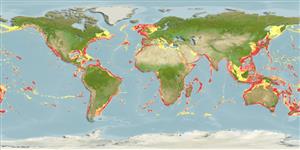Common names from other countries
Environment: milieu / climate zone / depth range / distribution range
Sinh thái học
Sống nổi và đáy; Mức độ sâu 0 - 2200 m (Ref. 275). Subtropical; 10°C - 24°C (Ref. 275), preferred 25°C (Ref. 107945); 79°N - 48°S, 180°W - 180°E
Circumglobal in subtropical and polar oceanic waters.
Length at first maturity / Bộ gần gũi / Khối lượng (Trọng lượng) / Age
Maturity: Lm ?, range 40 - ? cm Max length : 45.0 cm ML con đực/không giới tính; (Ref. 97142); 90 cm ML (female); Khối lượng cực đại được công bố: 1.8 kg (Ref. 275); Tuổi cực đại được báo cáo: 1.00 các năm (Ref. 77103)
Caught by dipnets (Ref. 417). Maximum depth from Ref. 59712. Oceanic but occurs near the surface at night (Ref. 417). Occasionally washed up on the beaches (Ref. 88739).
Life cycle and mating behavior
Chín muồi sinh dục | Sự tái sinh sản | Đẻ trứng | Các trứng | Sự sinh sản | Ấu trùng
Members of the class Cephalopoda are gonochoric. Male and female adults usually die shortly after spawning and brooding, respectively. Mating behavior: Males perform various displays to attract potential females for copulation. During copulation, male grasp the female and inserts the hectocotylus into the female's mantle cavity where fertilization usually occurs. Life cycle: Embryos hatch into planktonic stage and live for some time before they grow larger and take up a benthic existence as adults.
Roper, C.F.E., M.J. Sweeney and C.E. Nauen. 1984. (Ref. 275)
IUCN Red List Status (Ref. 130435)
CITES status (Ref. 108899)
Not Evaluated
Not Evaluated
Human uses
Các nghề cá: Tính thương mại
FAO - Các nghề cá: landings | FishSource | Biển chung quanh ta
Các công cụ
Các nguồn internet
Estimates based on models
Preferred temperature
(Ref.
115969): 5.7 - 17.2, mean 10.4 (based on 1723 cells).
Prior r = 0.51, 95% CL = 0.34 - 0.76, Based on 1 full stock assessment.
